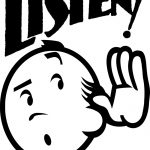 We usually place the responsibility of communication on the teller and train people to tell stronger, clearer stories. “Get to the point” we insist. But what if we understood communication as a space, inhabited by the dynamic of teller and listener? What if the power of one is contingent on the other.
We usually place the responsibility of communication on the teller and train people to tell stronger, clearer stories. “Get to the point” we insist. But what if we understood communication as a space, inhabited by the dynamic of teller and listener? What if the power of one is contingent on the other.
What if the listener was the one who drew out the best stories, and the quality of the story invariably reflected the quality of the listening? What if part of the responsibility of the storyteller was to create the listening that the story most needed? If no one is listening, could that also be the fault of the teller? This way, we create a richer understanding of what goes into the power of a story.
In a war zone, the sound of violence makes for a vigil of deafness. Everyone is on guard. It is listening with the gates to the heart padlocked. No one is going to penetrate there. It is too dangerous. The experience of an explosion is that it is an overwhelming sound event. People have to listen. And while they know the violence and the pain, the perpetrator often does it to make the victim feel the same pain as he does. “Now they will understand loss” “Now they will have to listen to me.”
Violence in every shape and form is an expression of and a form of non-listening. If we accept that, then listening is the greatest act against violence given to humankind.
The storyteller creates the listener. The Listener creates the storyteller. If no one is there to listen, there is no story. What’s more, if no one is listening, then war is inevitable. As Jesus once said, “They have eyes to see with but they do no see, and they have ears to hear with but they do not hear.”
